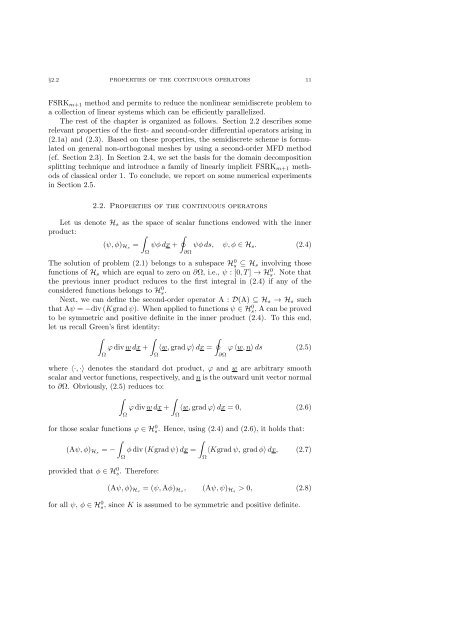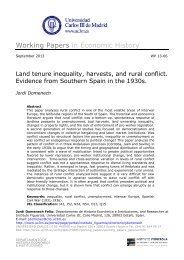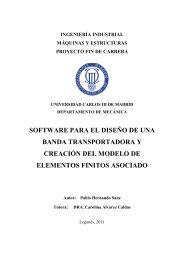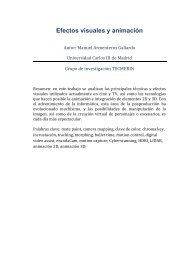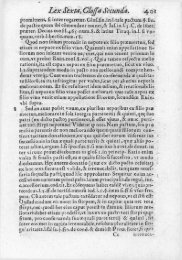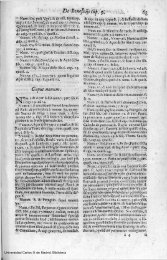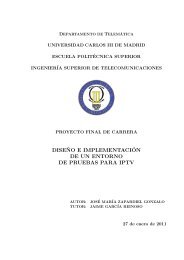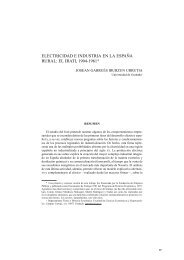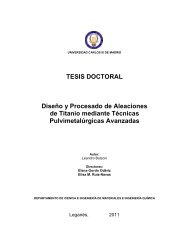Métodos miméticos de pasos fraccionarios - E-Archivo - Universidad ...
Métodos miméticos de pasos fraccionarios - E-Archivo - Universidad ...
Métodos miméticos de pasos fraccionarios - E-Archivo - Universidad ...
You also want an ePaper? Increase the reach of your titles
YUMPU automatically turns print PDFs into web optimized ePapers that Google loves.
§2.2 properties of the continuous operators 11<br />
FSRKm+1 method and permits to reduce the nonlinear semidiscrete problem to<br />
a collection of linear systems which can be efficiently parallelized.<br />
The rest of the chapter is organized as follows. Section 2.2 <strong>de</strong>scribes some<br />
relevant properties of the first- and second-or<strong>de</strong>r differential operators arising in<br />
(2.1a) and (2.3). Based on these properties, the semidiscrete scheme is formulated<br />
on general non-orthogonal meshes by using a second-or<strong>de</strong>r MFD method<br />
(cf. Section 2.3). In Section 2.4, we set the basis for the domain <strong>de</strong>composition<br />
splitting technique and introduce a family of linearly implicit FSRKm+1 methods<br />
of classical or<strong>de</strong>r 1. To conclu<strong>de</strong>, we report on some numerical experiments<br />
in Section 2.5.<br />
2.2. Properties of the continuous operators<br />
Let us <strong>de</strong>note Hs as the space of scalar functions endowed with the inner<br />
product:<br />
∫ <br />
(ψ, ϕ)Hs = ψϕ dx + ψϕ ds, ψ, ϕ ∈ Hs. (2.4)<br />
∂Ω<br />
Ω<br />
The solution of problem (2.1) belongs to a subspace H0 s ⊆ Hs involving those<br />
functions of Hs which are equal to zero on ∂Ω, i.e., ψ : [0, T ] → H0 s. Note that<br />
the previous inner product reduces to the first integral in (2.4) if any of the<br />
consi<strong>de</strong>red functions belongs to H0 s.<br />
Next, we can <strong>de</strong>fine the second-or<strong>de</strong>r operator A : D(A) ⊆ Hs → Hs such<br />
that Aψ = −div (Kgrad ψ). When applied to functions ψ ∈ H0 s, A can be proved<br />
to be symmetric and positive <strong>de</strong>finite in the inner product (2.4). To this end,<br />
let us recall Green’s first i<strong>de</strong>ntity:<br />
∫<br />
∫<br />
<br />
φ div w dx + ⟨w, grad φ⟩ dx = φ ⟨w, n⟩ ds (2.5)<br />
Ω<br />
Ω<br />
where ⟨·, ·⟩ <strong>de</strong>notes the standard dot product, φ and w are arbitrary smooth<br />
scalar and vector functions, respectively, and n is the outward unit vector normal<br />
to ∂Ω. Obviously, (2.5) reduces to:<br />
∫<br />
∫<br />
φ div w dx + ⟨w, grad φ⟩ dx = 0, (2.6)<br />
Ω<br />
Ω<br />
for those scalar functions φ ∈ H0 s. Hence, using (2.4) and (2.6), it holds that:<br />
∫<br />
∫<br />
(Aψ, ϕ)Hs = − ϕ div (Kgrad ψ) dx = ⟨Kgrad ψ, grad ϕ⟩ dx, (2.7)<br />
provi<strong>de</strong>d that ϕ ∈ H 0 s. Therefore:<br />
Ω<br />
Ω<br />
(Aψ, ϕ)Hs = (ψ, Aϕ)Hs, (Aψ, ψ)Hs > 0, (2.8)<br />
for all ψ, ϕ ∈ H 0 s, since K is assumed to be symmetric and positive <strong>de</strong>finite.<br />
∂Ω


